Information
LHCb-PAPER-2023-045
CERN-EP-2024-065
arXiv:2404.03375 [PDF]
(Submitted on 04 Apr 2024)
JHEP
Inspire 2774056
Tools
Abstract
A search for the fully reconstructed $B_s^0 \rightarrow \mu^+\mu^-\gamma$ decay is performed at the LHCb experiment using proton-proton collisions at $\sqrt{s}=13$ TeV corresponding to an integrated luminosity of $5.4 \mathrm{fb^{-1}}$. No significant signal is found and upper limits on the branching fraction in intervals of the dimuon mass are set \begin{align} {\cal B}(B_s^0 \rightarrow \mu^+\mu^-\gamma) < 4.2\times10^{-8}, &m(\mu\mu)\in[2m_\mu, 1.70] \mathrm{GeV/c^2} ,\nonumber {\cal B}(B_s^0 \rightarrow \mu^+\mu^-\gamma) < 7.7\times10^{-8}, &m(\mu\mu)\in[1.70, 2.88] \mathrm{GeV/c^2},\nonumber {\cal B}(B_s^0 \rightarrow \mu^+\mu^-\gamma) < 4.2\times10^{-8}, &m(\mu\mu)\in[3.92 , m_{B_s^0}] \mathrm{GeV/c^2},\nonumber \end{align} at 95% confidence level. Additionally, upper limits are set on the branching fraction in the $[2m_\mu, 1.70] \mathrm{GeV/c^2}$ dimuon mass region excluding the contribution from the intermediate $\phi(1020)$ meson, and in the region combining all dimuon-mass intervals.
Figures and captions
|
Fig1a.pdf [32 KiB] HiDef png [99 KiB] Thumbnail [60 KiB] |
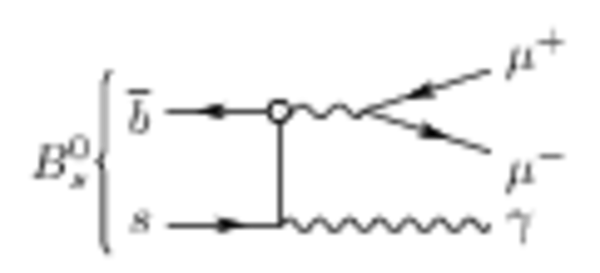
|
|
|
Fig1b.pdf [32 KiB] HiDef png [106 KiB] Thumbnail [64 KiB] |

|
|
|
Fig1c.pdf [32 KiB] HiDef png [49 KiB] Thumbnail [18 KiB] |

|
|
|
Fig1d.pdf [31 KiB] HiDef png [53 KiB] Thumbnail [20 KiB] |

|
|
|
Illustration of the $q^2$ spectrum in $ B ^0_ s \rightarrow \mu ^+ \mu ^- \gamma $ decays from Refs. [16,3] for a photon energy larger than 50 $\text{ Me V /}c^2$ . The grey band corresponds to the excluded region dominated by $ B ^0_ s \rightarrow { J \mskip -3mu/\mskip -2mu\psi } \gamma$ and $ B ^0_ s \rightarrow \psi {(2S)} \gamma$ decays. The Wilson coefficients and the FSR are highlighted in the region of the spectrum where they are dominant. The magnitudes are chosen for illustrative purposes. |
Fig2.pdf [18 KiB] HiDef png [144 KiB] Thumbnail [99 KiB] |

|
|
Mass distribution of $ B ^0_ s \rightarrow \phi \gamma $ candidates from data, used as control channel. The fit to the distribution is superimposed. |
Fig3.pdf [22 KiB] HiDef png [288 KiB] Thumbnail [204 KiB] |
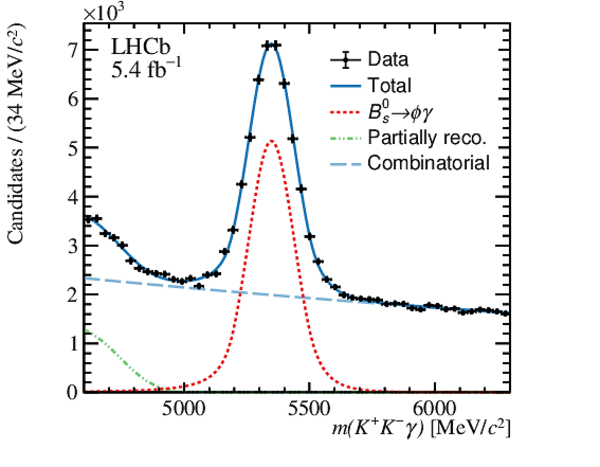
|
|
Mass distribution of $ B ^0_ s \rightarrow { J \mskip -3mu/\mskip -2mu\psi } \eta $ candidates from data, used as normalisation channel. The fit to the distribution is superimposed. |
Fig4.pdf [23 KiB] HiDef png [336 KiB] Thumbnail [230 KiB] |

|
|
Mass distribution of signal candidates in regions of $q^2$, (top-left) bin I, (top-right) bin II, (bottom-left) bin III, and (bottom-right) $\phi $ -veto bin. The result of the fit is overlaid and the different components detailed in the legend. |
Fig5a.pdf [21 KiB] HiDef png [274 KiB] Thumbnail [201 KiB] |
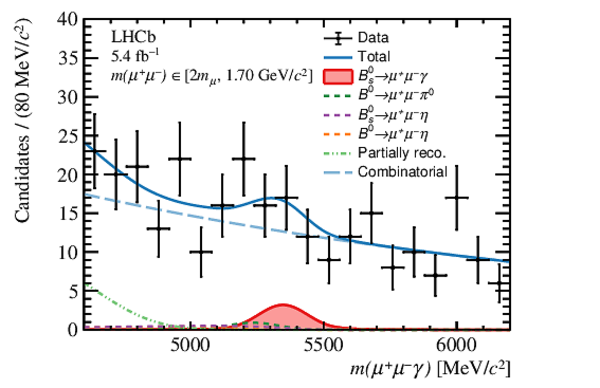
|
|
Fig5b.pdf [20 KiB] HiDef png [227 KiB] Thumbnail [167 KiB] |
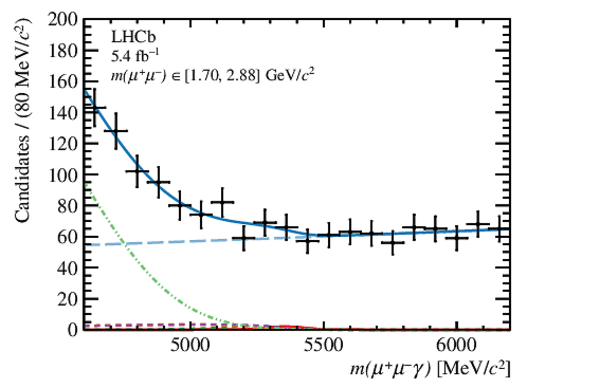
|
|
|
Fig5c.pdf [21 KiB] HiDef png [255 KiB] Thumbnail [179 KiB] |
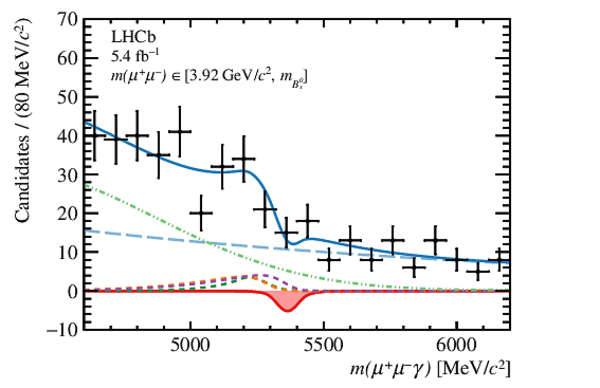
|
|
|
Fig5d.pdf [20 KiB] HiDef png [231 KiB] Thumbnail [161 KiB] |
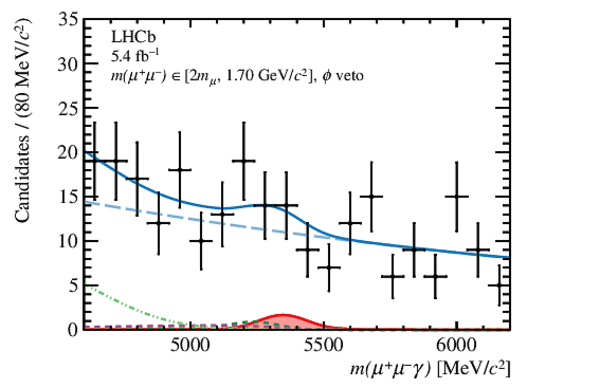
|
|
|
Results from the CL$_{\mathrm{s}}$ scan used to obtain the limit on $\mathcal{B} ( B ^0_ s \rightarrow \mu ^+ \mu ^- \gamma )$ in regions of $q^2$: (top-left) bin I, (top-right) bin II, (middle-left) bin III, (middle-right) bin I with $\phi $ veto, and (bottom) the whole $q^2$ range. The expected limit is shown by the red line and the 1$\sigma$ and 2$\sigma$ bands are shown as light blue and blue bands, respectively. The observed limit is shown as the solid black line. The two dashed lines intersecting with the observation indicate the limits at 90% and 95% CL for the upper and lower line, respectively. |
Fig6a.pdf [16 KiB] HiDef png [319 KiB] Thumbnail [227 KiB] |
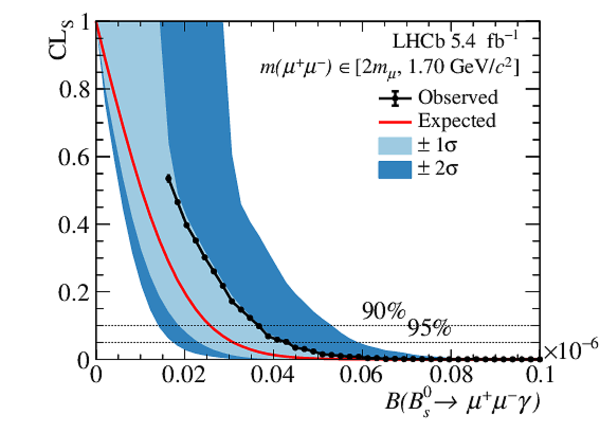
|
|
Fig6b.pdf [16 KiB] HiDef png [332 KiB] Thumbnail [230 KiB] |

|
|
|
Fig6c.pdf [18 KiB] HiDef png [380 KiB] Thumbnail [257 KiB] |

|
|
|
Fig6d.pdf [16 KiB] HiDef png [335 KiB] Thumbnail [238 KiB] |
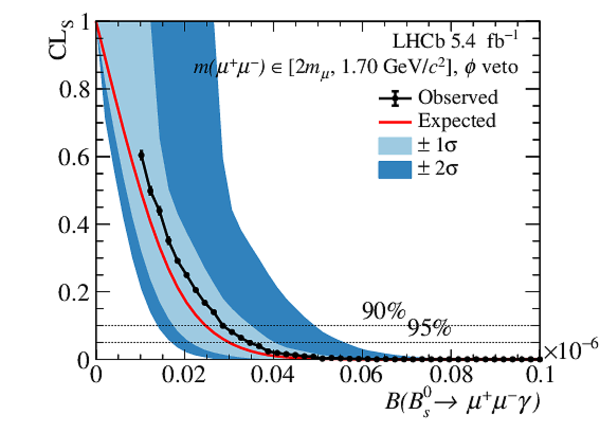
|
|
|
Fig6e.pdf [16 KiB] HiDef png [315 KiB] Thumbnail [223 KiB] |

|
|
|
Differential branching fraction of the $ B ^0_ s \rightarrow \mu ^+ \mu ^- \gamma $ decay in intervals of $q^2$. The black arrows represent the limits set in this paper at 95% CL. The limit set in the high-$q^2$ region with the indirect method from the $ B ^0_ s \rightarrow \mu ^+ \mu ^- $ measurement at 95% CL is represented in red [18]. SM predictions using different form factor calculations are represented in (blue) Ref. [9], (violet) Ref. [10], (yellow) Ref. [11], (green) Ref. [12], (orange) Ref. [14,15], and (pink) Ref. [13]. |
Fig7.pdf [18 KiB] HiDef png [320 KiB] Thumbnail [205 KiB] |
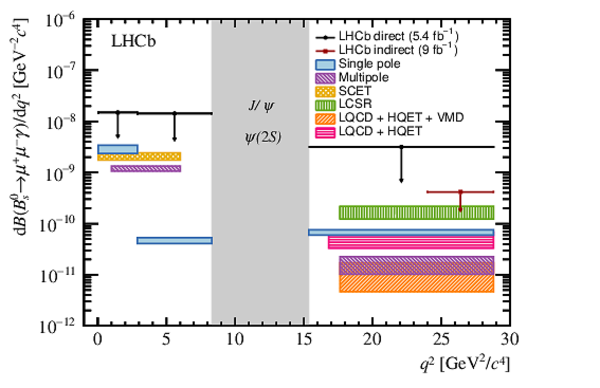
|
|
Animated gif made out of all figures. |
PAPER-2023-045.gif Thumbnail |

|
Tables and captions
|
Mass range definition, predicted branching fraction, and the expected fraction of signal yield in the different $q^2$ bins as calculated in Ref. [9]. |
Table_1.pdf [67 KiB] HiDef png [49 KiB] Thumbnail [24 KiB] tex code |

|
|
Efficiency ratios and single-event sensitivities, for each $q^2$ bin. The uncertainties on the efficiency ratios include the systematic uncertainties presented in Sec. 5.1. The uncertainties on $\alpha$ are the propagated uncertainties from $\mathcal{B} _\textrm{norm}$, $N_\textrm{norm}$ and $\epsilon_\text{norm}/\epsilon_{\text{sig}}$. |
Table_2.pdf [56 KiB] HiDef png [32 KiB] Thumbnail [16 KiB] tex code |

|
Created on 04 May 2024.
